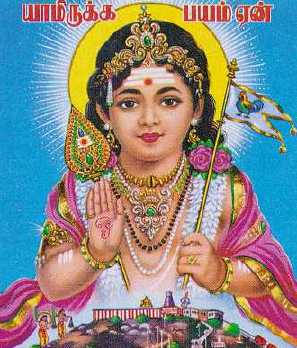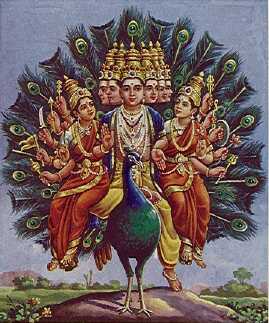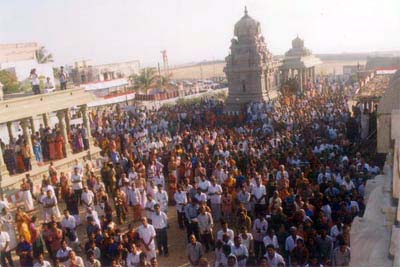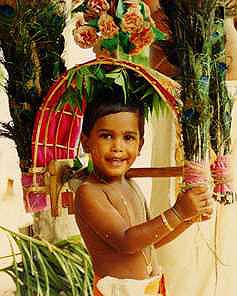
|
||||||
|
| ||||||
Tamils Abroad Seek Solace in Murugan
From Sudha G. Tilak (The Times of India News Service) (Chennai 12 March 1999) Endearing child-god and enduring symbol of Tamil cultural identity, pan-Indian wargod venerated by both sides of the conflict in Sri Lanka, the ancient and beguiling god Skanda or Murukan has assumed many forms over the centuries. Even today, Murukan and his cult are undergoing tumultuous change at the dawn of a new millennium. There has been a visible resurgence in both worship and research concerning the cult of Murukan, especially among Tamils spread across the globe but also among non-Tamils. Conferences, web sites and temples have been appearing with renewed vigor in the name of the playful warrior son of Hindu gods Shiva and Parvati, whose worship once flourished in North India as well as South. Recently the First International Conference Seminar on Skanda-Murukan was held on the outskirts of Chennai. For three days 135 scholarly delegates from 21 countries presented papers on the ancient cult citing earliest evidence from Harappa and Mohenjo-Daro civilization of 4,000 years ago down to the contemporary proliferation of Murukan worship across the Indian subcontinent and around the world. Patrick Harrigan, 48, a Chennai-based American scholar at the Institute of Asian Studies, has been conducting doctoral research on the cult of Skanda Murukan since 1987. A self-described Murukan devotee and servant, he is currently developing a Murugan Bhakti web site on the Internet which "will be a digital resource center for Murukan devotees, academicians and researchers all over the world." According to him the Tamil diaspora scattered across the world especially in the USA are "finding financial prosperity." Most, however, feel a spiritual void since leaving the mainstream of Tamil culture, particularly the cult of Murukan including pilgrimage and congregational worship. Even in large overseas communities such as in Mauritius, Tamils are discovering that their ancestors "did not bring with them from India the entire corpus of Kaumara doctrine and practice." "Tamils abroad are not content to have idly and dosai alone. With their newfound wealth they are building temples as centres of collective worship and cultural activity. And Murukan temples are the most popular among overseas Tamils," says Mr. Harrigan. With Murukan being the predominant family deity for most Tamils, temples are fast cropping up around the globe. The North American Hindu Temple Society alone has dedicated twenty temples to Murukan just in the past decade or so. One such mammoth project is now being constructed on the beachside of south Chennai. Funded entirely by non-resident Indian Tamils of the Madras-based Aru Padai Veedu Foundation, the temple complex incorporates all six great abodes of Murukan into one easily-accessible site.
Both in Tamil Nadu and abroad rival schools of thought contend in claiming Murukan. Some argue in favor of the worship of Murukan as a purely 'Tamil god' as opposed to the Aryan Skanda of Sanskritic lore. The atheistic Dravidian political movement, others say, has hijacked the deity and misrepresented him as a cultural symbol. Patrick Harrigan says, "Aside from Western prejudice favoring Sanskrit over Dravidian culture, the evidence suggests that this deity has been continuously worshipped in India since the time of the proto-Dravidian civilization of Mohenjo-Daro." Whatever be current academic opinion on the matter, it is clear that worship of the pan-Indian wargod is on the upswing in India and worldwide. Mr. Harrigan's exposure to the cult began in Sri Lanka in 1971 when he undertook a two-month pada yatra from Jaffna to Kadirgamam, where Sri Lankan Hindus, Buddhists and Muslims alike pay homage at a powerful and mysterious jungle shrine.
Propaganda pamphlets of the LTTE are also known to quote liberally from Tamil verses on Murukan. And yet, as researcher Harrigan is quick to point out, the same god is also the most popular and powerful deity of their Sinhalese opponents, who know the god as Kataragama Deviyo. "Murukan is such a flexible deity that he is regarded as a religious reference point by diverse people in Sri Lanka and elsewhere," says Mr. Harrigan. He observes that in recent decades the number of women and non-Tamils participating in practices like pada yatra has been on the rise. "This is a god who accepts worship from anyone -- Tamils, non-Tamils, high caste, low caste or no caste at all. Anyone can make a vow with the god and he delivers. Hence his widespread and still growing popularity comes as no surprise." Steps are on in Chennai to create an international organisation to promote the study of Murukan. Research and documentation of aspects from past and present on the cult of Murukan, organisation of conferences and lecture tours, translation of Kaumara texts from various languages and dialogue with representatives of other faiths are among its aims. With interest in him burgeoning around the world, the 4,000-plus year old child god must be smiling to see the outcome of these changing times for the cult of Skanda-Murukan. |



 Mr.Harrigan, who has joined the 40-day pilgrimage from Trincomalee annually since 1988, recalls how "the god's unseen hand keeps us out of harm's way even as fighting rages. Longtime devotees know that even a live war to us is but a war game to Him. 'Why fear?' is the devotees' motto."
Mr.Harrigan, who has joined the 40-day pilgrimage from Trincomalee annually since 1988, recalls how "the god's unseen hand keeps us out of harm's way even as fighting rages. Longtime devotees know that even a live war to us is but a war game to Him. 'Why fear?' is the devotees' motto."